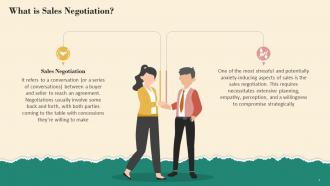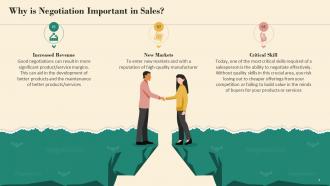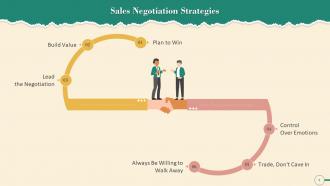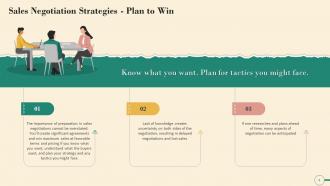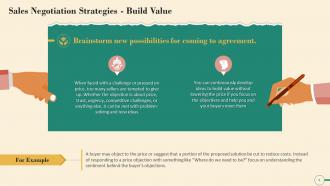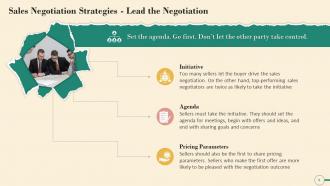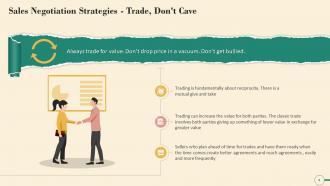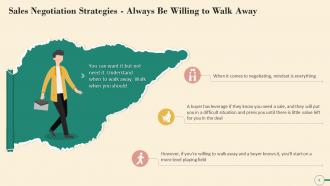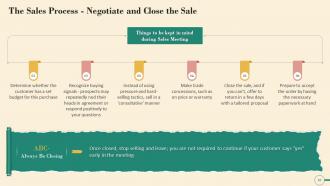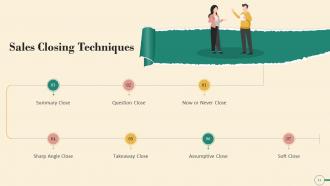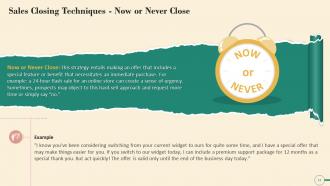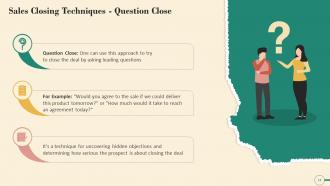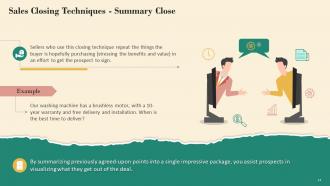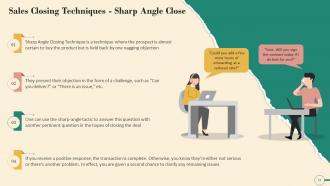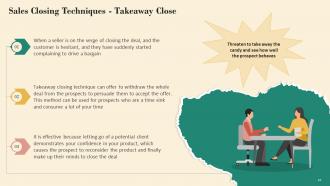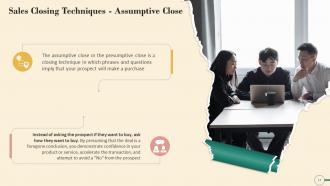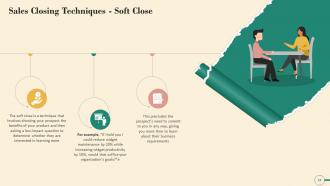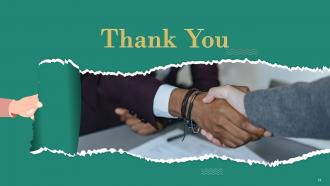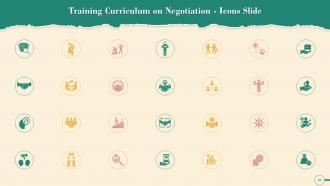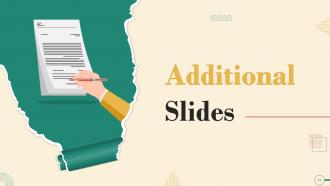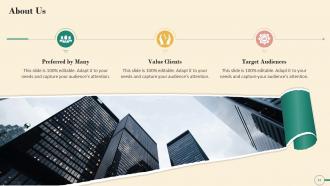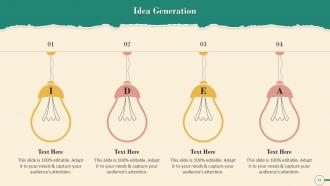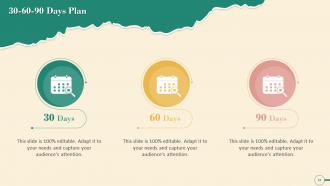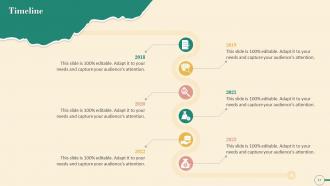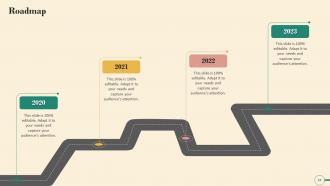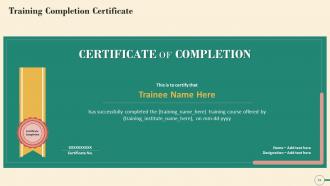Guide To Effective Sales Negotiation Training Ppt
This set of slides introduces the concept of sales negotiations. It discusses the importance of negotiation in sales along with its process. It also mentions some essential negotiation strategies and closing techniques in sales.
You must be logged in to download this presentation.
PowerPoint presentation slides
Presenting Guide to Effective Sales Negotiation. Each slide is well crafted and designed by our PowerPoint experts. This PPT presentation is thoroughly researched by the experts, and every slide consists of appropriate content. All slides are customizable. You can add or delete the content as per your need. Not just this, you can also make the required changes in the charts and graphs. Download this professionally designed business presentation, add your content and present it with confidence.
Content of this Powerpoint Presentation
Slide 1
This slide provides information about sales negotiations. It emphasizes that sales negotiation is a conversation between a buyer and seller to reach an agreement. These negotiations, typically, involve some back and forth, with both parties bringing concessions to the table.
Slide 2
This slide explains the importance of negotiation in sales. It mentions that good negotiations can result in more significant product/service margins which can aid in the development of better products and the maintenance of better products/services. It also highlights that today, one of the most critical skills required of a salesperson is the ability to negotiate effectively. Without quality skills in this crucial area, you risk losing out to cheaper offerings from your competition or failing to build value in the minds of buyers for your products or services.
Slide 3
This slide depicts the most common sales negotiation strategies. The strategies are: Plan to win, Build Value, Lead the Negotiation, Control Over Emotions, Plan to Win, Trade, Don't Cave In, and Always Be Willing to Walk Away
Slide 4
This slide demonstrates the importance of planning as a sales negotiation strategy. It emphasizes that the importance of preparation in sales negotiations cannot be overstated. Lack of knowledge creates uncertainty on both sides of the negotiation, resulting in delayed negotiations and lost sales. Many aspects of negotiation can be anticipated, if one conducts research and plans ahead of time.
Slide 5
This slide depicts Building Value as a sales negotiation strategy. It emphasizes that when confronted with a challenge or under pressure to sell, far too many sellers are tempted to give up. Whether the objection is based on price, trust, urgency, competitive challenges, or something else, it can be met with problem-solving and new ideas. It also mentions that if you focus on objectives and help you and your buyers meet them, you can continuously develop ideas to build value without lowering the price.
Slide 6
This slide showcases Leading the Negotiation as a sales negotiation strategy. It highlights that many sellers let the buyer drive the sales negotiation. On the other hand, top-performing sales negotiators are twice as likely to take the initiative. Sellers must take the initiative. They should set the agenda for meetings, begin with offers and ideas, and end with sharing goals and concerns. It also mentions that sellers who make the first offer are more likely to be pleased with the negotiation outcome.
Slide 7
This slide explains how emotions can be used as a sales negotiation strategy. It emphasizes the fact that sales negotiations are highly emotional events. The best sales negotiators intentionally manipulate buyers emotions and are more likely to be emotionally prepared during negotiations. It also mentions that the best negotiators manage their anger and frustration, which allows them to focus. When they are worried or anxious, they smoothen themselves out to do what needs to be done without conflict or fear of loss.
Slide 8
This slide tells the importance of Not Caving In as a sales negotiation strategy. It emphasizes the importance of reciprocity in trading. There is an exchange of goods/services, and trading has the potential to increase the value for both parties. Both parties give up something of lower value in exchange for something of greater value. It also emphasizes that sellers who prepare for trades ahead of time and have them ready when the time comes create better, more frequent agreements and reach agreements more frequently.
Slide 9
This slide explains always being Willing to Walk Away as a sales negotiation strategy. It mentions that mindset plays a significant role when it comes to negotiating. If a buyer has leverage if they know you need a sale, they will put you in a difficult situation and press you until there is very little value in a deal. It also highlights that you'll start on a more level playing field, if you're willing to walk and a buyer knows it.
Slide 10
This slide provides information about what to be kept in mind during a sales meeting. The points are: Determining whether the customer has a set budget for this purchase, recognizing buying signals, Selling in a 'consultative' manner, Making trade concessions, such as on price or warranty, Close the sale, and if you can't, offer to return in a few days with a tailored proposal. It also highlights the ABC (Always Be Closing), which explains that once closed, stop selling and leave; you are not required to continue if your customer says "yes" early in the meeting.
Slide 11
This slide showcases kinds of Sales Closing Techniques. The techniques are: Now or Never Close, Question Close, Summary Close, Sharp Angle Close, Takeaway Close, Assumptive Close, and Soft Close.
Slide 12
This slide explains the Now or Never sales closing technique, which entails making an effort that includes a special feature or benefit that requires an immediate purchase. A twenty-four -hour flash sale for an online store can instill a sense of urgency. It also emphasizes that sometimes prospects may object to this aggressive sales approach and ask for more time or simply say "no."
Slide 13
This slide depicts question close, a sales closing technique. The technique includes closing the deal by asking leading questions, e.g., "Would you agree to the sale if we could deliver this product tomorrow?" or "How much would it take to reach an agreement today?". It also highlights that this technique uncovers hidden objections and determines how serious the prospect is about closing the deal.
Slide 14
This slide describes the Summary Close, which is a sales closing technique. In this technique, sellers repeat the items the buyer is likely to purchase to entice the prospect to sign. It also mentions that by condensing agreed-upon points into a single impressive package, you help prospects visualize what they genuinely get out of the deal.
Slide 15
This slide describes a sales closing technique known as the sharp angle close. A sharp angle closing technique is used when a prospect is almost certain to purchase a product but is held back by one nagging objection. They present their objection as a challenge, such as “Can you deliver?" or “There is an issue," etc. It also mentions using the sharp-angle tactic to answer this question with another relevant question to close the deal.
Slide 16
This slide depicts a sales closing technique known as the takeaway close. When a seller is on the verge of closing the deal, and the customer is hesitant, he/she suddenly starts complaining to drive a bargain. Takeaway closing technique can offer to withdraw the whole deal from the prospects to persuade them to accept the offer. This method can be used for prospects who are a time sink and consume a lot of your time.
Slide 17
This slide provides information on assumptive close that is a sales closing technique. The assumptive close or the presumptive close is a closing technique in which phrases and questions imply that your prospect will make a purchase. It also highlights that in this technique instead of asking the prospect if they want to buy, ask how they want to buy.
Slide 18
This slide explains the "soft close," a sales closing technique. The soft close is described as a technique that involves showing your prospect the product's usefulness and then asking a low-impact question to determine whether they are interested in learning more. It also emphasizes how this technique precludes the prospect's need to commit to you in any way, giving you more time to learn about their business needs.
Guide To Effective Sales Negotiation Training Ppt with all 34 slides:
Use our Guide To Effective Sales Negotiation Training Ppt to effectively help you save your valuable time. They are readymade to fit into any presentation structure.
-
Visually stunning presentation, love the content.
-
“As you have innovative ideas and they are all customizable, this saves a huge chunk of your time to prepare well-read presentations.”





































